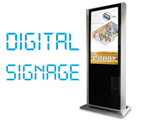Ever been in a large convention facility for the first time? Running a bit late and don’t know what room your meeting is in? Even if you have the room number, is the signage good enough to point you down the right hallway? If you are anything like me you will wander around just long enough to now be late to the meeting.
The proliferation of digital signage has led to a wide variety of uses within a single building. Solving my dilemma is a great use of the technology. First to discuss is the locations of various signs. Primary locations will be at the entrances to the building and beginnings of major corridors. This will help people unfamiliar with the building get to the correct hallway. At the doors to conference rooms, many organizations will post a banner showing the meetings and times. This helps people confirm they are walking to the correct room. Replacing the banner with a digital sign at the conference room doorway will provide flexibility with late changes to meeting times and locations.
Content on the screens is our next consideration. After all, poor signage content can be worse than no signage at all. At the entrances monitors will display a building wide map with a meeting list. If the building is sufficiently full the meeting list may even scroll. At the beginnings of corridors the building map will be limited to that specific area and the meeting list will also be limited. Maps will be positioned correctly so that rooms that look left on the map are indeed left to the viewer. Additional maps need to be created because monitors on opposite sides of a corridor will have mirror imaged maps. Finally monitors at the conference room doors will display meeting times related to only that room. Logos and other information can be added to the screen to further identify with the meeting party.
The most important consideration, however, is one of basic operations. Smooth operation of the digital signage system is critical to its success. When evaluating the systems to be installed a very basic question must be answered. What room scheduling software is being used in the facility? Next, how easy is that software to integrate with your digital signage software? How can we marry these two worlds, so we are not creating duplicate information? This is one of the big secrets of success. Do it right and the signage software will automatically retrieve room usage schedules and update the monitors accordingly.
At Acoustics By Design, we design digital signage systems that meet the needs of your facility and expand with your future growth. Designing these systems independently is one of the keys to bidding a competitive package.
